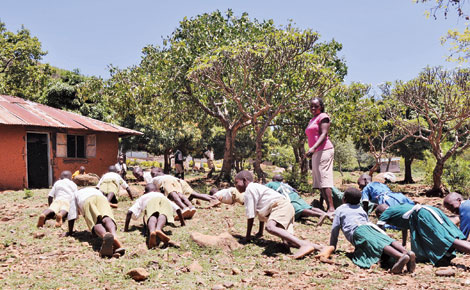 |
|
Akingili Primary School pupils during physical education. [PHOTOS: NYWAWIRA/ STANDARD] |
By GATONYE GATHURA
Kenya: Rural children are physically fit than their urban peers who are inactive and obese, the second national report card on youth physical health has revealed.
The Report Card on Physical Activity and Body Weight of Children and Youth released yesterday showed parents have largely failed to keep their children active and physically healthy, exposing them to lifestyle diseases.
Compared to the first scorecard released in 2011 by the same scholars at Kenyatta University and the Ministry of Health, children and youth are less active, watch more television and are obese.
However, Kenyan children are more active and less obese than their counterparts in the West. But survey leader Prof Vincent Onywera warns Kenyan children are quickly taking after their counterparts in the developed world.
“Even with all the political and economic gains made by women, the most at risk are girls, who are less active compared to boys everywhere. They are more obese hence highly exposed to the risk of lifestyle diseases and a possible short life span,” Onywera, a senior lecturer at Kenyatta University said yesterday during the launch of the score-card.
Mothers, particularly the educated, have been faulted especially for pamepering or ‘spoiling’ their daughters.
“Among mothers with a diploma, higher diploma or degree it was much less likely that their children and especially girls would meet the various guidelines for physical activity,” he said. The Ministry of Education’s policy requires public schools to allocate 35 minutes of physical education (PE) three times a week in the school curriculum.
But unfortunately information collected on the groups indicated that PE sessions even where scheduled are being used to teach other examinable subjects. “This is because of pressure on schools to perform well in national examinations.”
The World Health Organisation recommends that children and youth aged 5-17 accumulate at least 60 minutes daily of vigorous to moderate physical activity.
Most girls, both rural and urban, were found to be obese or overweight compared to boys. The research team comprising Ministry of Health officials blamed this on societal glorification of big women.
“Cultural desirability whereby being overweight, “rounder” is an admired trait and seen as a sign of wealth and prestige, particularly in girls.”
The study showed that the society’s expectations that girls should be modest could be hurting the children.
All over, boys were found to be walking and running more than girls which is good for their health but on the other hand the females sit more and watch television.
‘Go girl Go!’ The survey seems to be telling the girls. ‘Be brash, run, jump and break the glass ceiling.’
Stay informed. Subscribe to our newsletter
“This report card will be produced periodically to monitor health behaviours of Kenyan children and youth as a means of holding all accountable for the health of our children,” said Onywera. Despite beating the rural children in national examinations, urban children have one or two things to learn from their rural counterparts on how to keep physically fit.
Besides active play, the researchers say, rural youth reported spending part of their leisure time doing household chores
“For example, rural children and youth reported fetching water from distant streams, fetching firewood, gardening, and running associated with cattle herding,” he said.
On the other hand when the rural boy is herding goats his city counterpart is studying, watching television or listening to the radio.
Despite being viewed as taking away play time, researchers say household chores are beneficial to the health of rural children.
“We know so. But when my children go to the village they follow me back to Nairobi within a day or two. They claim in the village it is too boring and there is unwelcome back breaking manual work,” says Jean Ndena, a nurse at a city hospital.
The researchers say it is important for children to spend more time in rural areas or at least do household chores while in the urban areas.
According to the score-card parents interviewed said they were more active in their youth compared to their children.
But even in urban areas there are some discrepancies, children in private schools have more obese cases compared to those in public institutions.
Those in public schools especially boys are more likely to be running to and from school while their counterparts in private institutions are most likely driven to their destinations.
In private schools children are more likely to be involved in posh and less active games while those in public institutions engage in less prestigious but more vigorous games.
“Children from rich families were found to predominantly participate in sports perceived as more prestigious and associated with higher costs, while the poorer dominated in inexpensive sports such as soccer, netball, or hockey.”
Although the study did not get into eating habits, it showed a high number of children are underweight especially in rural areas which is not good for their health and social mobility.
 The Standard Group Plc is a
multi-media organization with investments in media platforms spanning newspaper
print operations, television, radio broadcasting, digital and online services. The
Standard Group is recognized as a leading multi-media house in Kenya with a key
influence in matters of national and international interest.
The Standard Group Plc is a
multi-media organization with investments in media platforms spanning newspaper
print operations, television, radio broadcasting, digital and online services. The
Standard Group is recognized as a leading multi-media house in Kenya with a key
influence in matters of national and international interest.
 The Standard Group Plc is a
multi-media organization with investments in media platforms spanning newspaper
print operations, television, radio broadcasting, digital and online services. The
Standard Group is recognized as a leading multi-media house in Kenya with a key
influence in matters of national and international interest.
The Standard Group Plc is a
multi-media organization with investments in media platforms spanning newspaper
print operations, television, radio broadcasting, digital and online services. The
Standard Group is recognized as a leading multi-media house in Kenya with a key
influence in matters of national and international interest.









